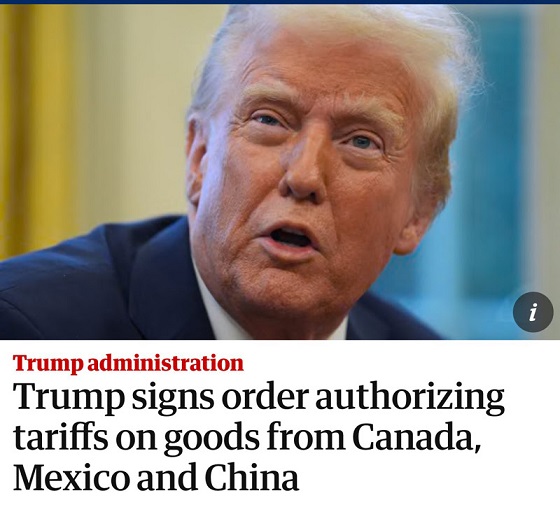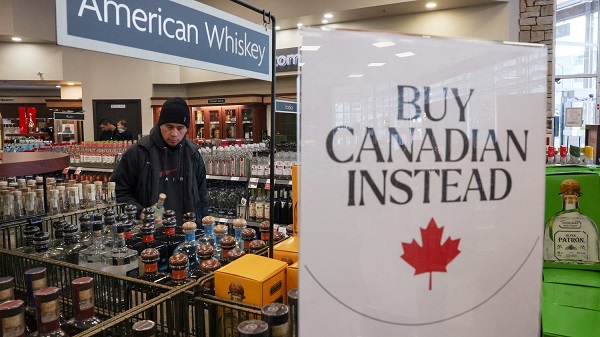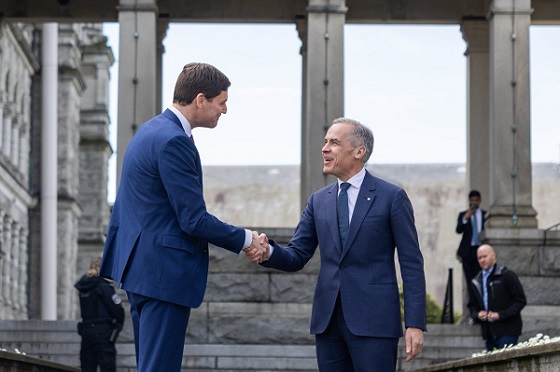Business
A Lone Federal Political Voice Opposing Retaliatory Tariffs

News release from Max Bernier, Leader of The People’s Party of Canada
It’s important to understand that the 25% tariffs announced by President Trump today are NOT imposed on Canada — they will be paid by American consumers and businesses who buy goods imported from Canada. Tariffs are a tax, and Americans who will have to pay more or go without our products will be the first to suffer.
Of course, Canadian exporters of these goods will as a consequence lose clients, contracts and sales, and will be forced to cut down on production and lay off workers. Or they will lower their prices to keep market shares and will see their profits diminish.
Because 75% of our exports go south of the border, our economy will for sure be very negatively impacted by this.
The stupidest thing our government can do however to deal with this crisis is to impose the same kind of tariffs “dollar for dollar” against US imports.
The US economy is ten times bigger than ours, much less reliant on trade than ours, and much less dependent on our market than we are on theirs.
Not only would retaliatory tariffs have much less impact on American exporters, they would immediately impoverish Canadian consumers forced to pay more for imported goods, as well as destabilize Canadian businesses that need inputs from the US in their production processes. It would more than double the harm of the US tariffs to our economy.
Trade wars are bad for everyone, but they are much worse for a small country with fewer options. We simply cannot win a trade war with the US. It’s very unlikely that Trump will back down. All we will do is provoke a massive economic crisis in Canada, until we are forced to capitulate.
Another self-destructive thing to do would be to set up giant “pandemic-level” bailout plans to support everyone affected by this trade war. This will simply bankrupt our governments even more than they already are and make us even weaker.
So what should we do?
1. Double down on efforts to control our border, crack down on fentanyl dealers, deport all illegals, and impose a complete moratorium on immigration, to answer Trump’s immediate concerns about Canada.
2. Tell the US administration that we are ready to renegotiate North American free trade and put dairy supply management and other contentious issues on the table.
3. Wait and see to what extent Trump is willing to keep tariffs in place despite the harm it does to the US economy. Despite his pretenses that Americans don’t need our stuff, the reality is that on the contrary they have few other options for crucial resources like oil, lumber, uranium and other minerals, etc. He will stop acting like a bully when he sees that he can get more results by sitting down and negotiating.
4. To reduce our dependence on the US market, immediately implement an ambitious plan to tear down interprovincial trade barriers and help our impacted exporting industries find alternative markets in other countries.
5. Immediately implement a series of bold reforms to make our economy more productive, including: reduce corporate and personal taxes, abolish the capital gains tax, abolish all corporate subsidies, get rid of excessive regulation, remove impediments to the exploitation and export of natural resources, drastically cut government spending, mandate the Bank of Canada to stop printing money and start accumulating a gold reserve to prepare for the global monetary reset (which is likely part of Trump’s plan).
In short, instead of adopting a suicidal strategy to confront Trump, we must do what we should have done a long time ago to strengthen our economy and our bargaining position. The transition will be rough, but not as much as complete bankruptcy and disintegration.
Business
Trump family announces Trump Mobile: Made in America, for America

 MxM News
MxM News
Quick Hit:
On the 10-year anniversary of Donald Trump’s iconic campaign launch, the Trump family announced the debut of Trump Mobile, a new wireless company offering American-built smartphones, 5G coverage, and a values-driven alternative to Big Tech carriers.
Key Details:
-
Donald Trump Jr. and Eric Trump introduced Trump Mobile’s flagship service Monday, calling it a “transformational” alternative aimed at “our nation’s hardest-working people.”
-
The “47 Plan,” priced at $47.45/month, offers unlimited talk, text, and data, free international calls to U.S. military families, telehealth, roadside assistance, and no credit checks.
-
Trump Mobile’s customer support is fully U.S.-based and live 24/7—“not automated,” the company says—while a new American-made “T1 Phone” is slated for release in August.
Diving Deeper:
Marking ten years since President Donald Trump descended the golden escalator to launch his first campaign, the Trump Organization on Monday announced its boldest private sector move yet: Trump Mobile.
Flanked by company executives, Donald Trump Jr. and Eric Trump unveiled the new cellular service, touting it as a patriotic, people-first alternative to legacy providers. “We’re building on the movement to put America first,” Trump Jr. said in a statement. “We will deliver the highest levels of quality and service.”
The cornerstone of Trump Mobile is the 47 Plan. Offered for $47.45/month, the plan includes unlimited data, full 5G coverage across all three major carriers, and a suite of benefits tailored to middle-class families, truckers, veterans, and anyone tired of paying premiums to companies that don’t share their values.
Among the key perks: 24/7 American-based customer service (with “real people,” not bots), comprehensive device protection, roadside assistance through Drive America, and telehealth services including mental health support and prescription delivery. Most notably, the plan includes free international calling to over 100 countries—an effort the Trump family says honors U.S. military families stationed abroad.
“We’re especially proud to offer free long-distance calling to our military members and their families,” said Eric Trump. “Those serving overseas should always be able to stay connected to the people they love back home.”
Unlike traditional providers, Trump Mobile advertises no contracts and no credit checks, appealing to a demographic long underserved by mainstream telecom giants. “Hard-working Americans deserve a wireless service that’s affordable, reflects their values, and delivers reliable quality they can count on,” Eric Trump added.
The company is also preparing to launch the T1 Phone in August—a sleek, gold smartphone “engineered for performance” and “proudly designed and built in the United States.” With that, the Trump Organization is not just entering the mobile market—it’s staking a claim as a direct competitor to Apple and Samsung.
Business
Carney praises Trump’s world ‘leadership’ at G7 meeting in Canada

From LifeSiteNews
Canada’s prime minister said it was a ‘great honor’ to host the U.S. president and praised him for saying Canada wants to work with the U.S. ‘hand-in-hand.’
During the second day of the G7 leaders meeting in the Kananaskis area in Alberta, Canadian Prime Minister Mark Carney praised U.S. President Donald Trump’s world “leadership” despite saying many negative things about him during his election campaign.
While speaking to reporters Monday, Trump hinted that a new trade deal between Canada and the United States was potentially only “weeks” away. This came after a private meeting with Carney before the official G7 talks commenced.
“We’ve developed a very good relationship. And we’re going to be talking about trade and many other things,” Trump told reporters.
Carney was less vocal, however. He used the opportunity to tell reporters he was happy Trump came to his country for the G7 meeting, saying it was a “great honor” to host him.
“This marks the 50th birthday of the G7, and the G7 is nothing without U.S. leadership,” Carney told reporters.
He then spoke about Trump’s “personal leadership” on world issues and praised him for saying Canada wants to work with the U.S. “hand-in-hand.”
Carney ran his election campaign by claiming the Conservative Party would bow to Trump’s demands despite the fact that the party never said such things.
During his federal election campaign, Carney repeatedly took issue with Trump and the U.S. that turned into an anti-American Canadian legacy media frenzy.
However, the reality is, after Carney won the April 28 federal election, Trump praised him, saying, “Canada chose a very talented person.”
Many political pundits have said that Carney owes his win to Trump, as the U.S. president suggested on multiple occasions that he would rather work with Carney than conservative leader Pierre Poilievre.
Trump has routinely suggested that Canada become an American state in recent months, often making such statements while talking about or implementing trade tariffs on Canadian goods.
As for Carney, he has said his government plans to launch a “new economy” in Canada that will involve “deepening” ties to the world.
-

 Health20 hours ago
Health20 hours agoLast day and last chance to win this dream home! Support the 2025 Red Deer Hospital Lottery before midnight!
-

 Business2 days ago
Business2 days agoCarney’s European pivot could quietly reshape Canada’s sovereignty
-

 conflict1 day ago
conflict1 day ago“Evacuate”: Netanyahu Warns Tehran as Israel Expands Strikes on Iran’s Military Command
-

 Aristotle Foundation23 hours ago
Aristotle Foundation23 hours agoThe Canadian Medical Association’s inexplicable stance on pediatric gender medicine
-

 Alberta2 days ago
Alberta2 days agoAlberta’s grand bargain with Canada includes a new pipeline to Prince Rupert
-

 Energy1 day ago
Energy1 day agoCould the G7 Summit in Alberta be a historic moment for Canadian energy?
-

 Crime1 day ago
Crime1 day agoMinnesota shooter arrested after 48-hour manhunt
-

 Bruce Dowbiggin1 day ago
Bruce Dowbiggin1 day agoWOKE NBA Stars Seems Natural For CDN Advertisers. Why Won’t They Bite?





